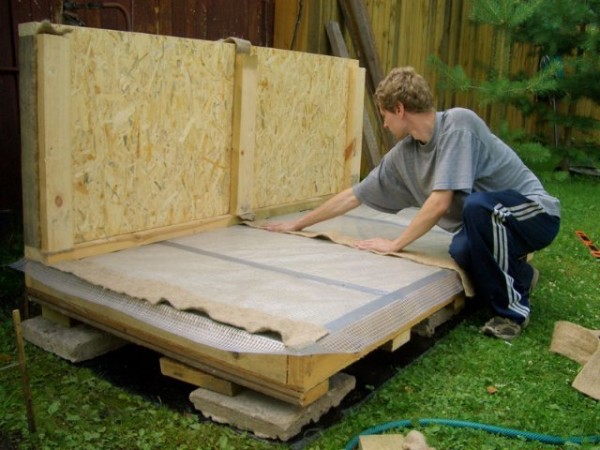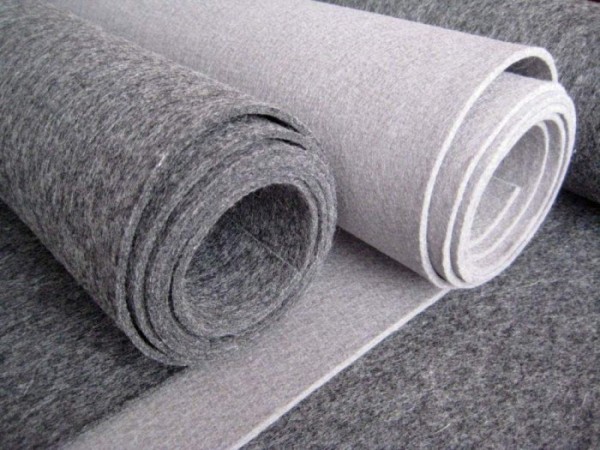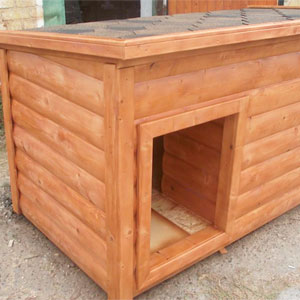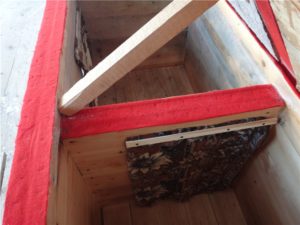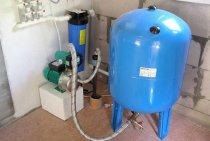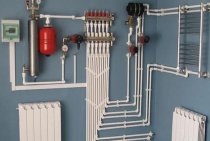Thermal insulation options
So, how to insulate a dog house? Let's look at several options of varying complexity.
Felt
In terms of time and money, this option is the easiest and cheapest.
It can be implemented with your own hands in just a couple of hours.
- Mats are cut out of thick felt according to the size of the walls, roof and floor. For cutting, a regular sharp knife is used.
- They are fastened inside the booth with the roof removed with ordinary roofing nails with wide hats.
- The roof is in place.
What is the result? We get a fairly effective insulation that will not be blown by the wind. The material is environmentally friendly and will not harm the health of our pet
No less important - it has good vapor permeability: there will be no dampness in the booth
Mineral wool
Let's be honest: its use is rather doubtful. The design will turn out to be quite complex; in addition, for the sake of high-quality insulation, the walls will have to be made very thick.
How to insulate a dog house with mineral wool?
The instruction for thermal insulation work itself is familiar to anyone who has ever performed insulation of a loggia or balcony with the help of this heater:
- The walls are covered with a vapor barrier, which is attached with a stapler.
- On the walls around the perimeter of each, a crate is stuffed from a bar of 50x50 millimeters.
- Mineral wool mats are cut to size with a knife and inserted into the crate, after which the second sheet of vapor barrier is hemmed with a stapler.
- Outside, along the crate, the booth is sewn up with plywood, OSB or wooden clapboard.
Styrofoam
Against the background of the previous insulation, the foam has several noticeable advantages:
- It provides the same effective thermal insulation with less thickness.
- Styrofoam does not cake and does not get wet (therefore, it is often used to insulate balconies). Its heat-insulating qualities do not deteriorate over time.
How to insulate a dog house for the winter with foam? Minus unnecessary vapor barrier - just like mineral wool.
Along with home-made designs, already insulated dog houses can be found on sale. In most cases, it is the foam that is used in them, laid between the two walls of the lining. To look at such a product is quite informative.
Roll insulation
Let's be realistic: with an open hole, thermal insulation will not significantly affect the temperature in the booth. It is much more reasonable not to increase the thickness of the walls, but to reliably protect the dog from drafts.
In this case, you can get by with inexpensive roll heaters.
Foamed polyethylene provides reliable wind protection and good thermal insulation already at a thickness of 4-6 millimeters
. It is attached to the walls, floor and roof of the booth with the same stapler, after which it is again sheathed with any durable material. The crate is not needed: short self-tapping screws can be screwed directly through the insulation into the boards, so long as they do not stick out inside.
Penofol - an advanced version of roll insulation
. On one side of the polyethylene foam, aluminum foil is applied, which reflects infrared radiation. Fixed between the inner and outer walls of the booth, the material will further reduce heat loss.
Does the dog freeze in the booth in winter
How does your pet winter? Does the dog get cold in its kennel, or does it have enough hair to keep warm? Of course, it freezes, especially if it is not a long-haired breed, but also its dwelling (booth) also runs the risk of freezing, leaking or being too ventilated. If your dog is really a friend, then you need to treat it accordingly, that is, create the proper conditions for wintering.
First you need to check whether the booth is located in the right place or if it should be moved to another:
- the entrance, if possible, should be located in a place where the wind movement is minimal (lulls);
- in rainy weather, water should not flow under the kennel, so it is necessary to make insulation or place the booth on an elevated area;
- the kennel should not be located under the open sun, but an excessive shadow is not an option - you need to find a compromise;
- the dimensions of the booth must correspond to the size of the pet, i.e. it should not be cramped, but it should not be too spacious either;
- The best material for a dog kennel is natural wood.
The booth should be insulated in the same way as any other structure, taking into account all the nuances of insulation: proper protection from wind, frost and rain. You can perform insulation from the inside, it is appropriate to do it when the structure can be disassembled and assembled or if there is sufficient internal space.
If the booth is already ready and there is no way to disassemble the structure, you will have to perform external insulation, then you should take care of the external finish so that the kennel has a decent aesthetic appearance.
To be sure of the result of thermal insulation, it is necessary to insulate all surfaces of the booth: walls, roof and floor.
Do I need to insulate a dog house?
Dogs of different breeds tolerate low temperatures differently, but most of them cope well with the cold and even do not mind sleeping in the snow. This is especially true for dogs of hunting breeds, since they are distinguished by dense and thick hair.
But in order to understand whether a dog freezes in winter or not, taking into account only its breed is not enough. Dogs of the same breed tolerate cold differently because they are grown and live in different conditions.
Even the most cold-resistant animal, which was bred in an apartment or a warm house, will not be able to normally survive the winter on the street.
In the conditions of the Russian winter, the dog needs a warm booth
The dog's body adapts to environmental conditions, which affects the condition and quality of the coat. The dogs kept in the apartment do not have an undercoat, since they do not need it. If such a dog is allowed outside, especially in winter, it will be cold.
It is worth paying attention to the temperature that is set in the booth in the winter. If the dog house is made of wood (the most common material), then the temperature in the booth will differ by a maximum of 3-4 degrees from the ambient temperature
This is due to the fact that air circulates freely through the outlet and does not allow heat to linger inside the dog house. Many owners hang a curtain on the outlet for the winter, however, this is not enough to create full and comfortable conditions for the winter for the dog.
Do I need to insulate the dog house for the winter
Many owners of four-legged pets think about whether the dog is cold in the booth in winter. There is no unequivocal answer to the question - it all depends on the climatic features of the region and the breed of the dog.
Cynologists agree that long-haired, wire-haired and short-haired dogs with a thick undercoat can withstand frosts down to -40 ° C. Some breeds, such as the Husky, the Leonberg, the Moscow Watchdog and the Bernese Mountain Dog, prefer to sleep in the snow and stay outside even with the onset of cold weather.
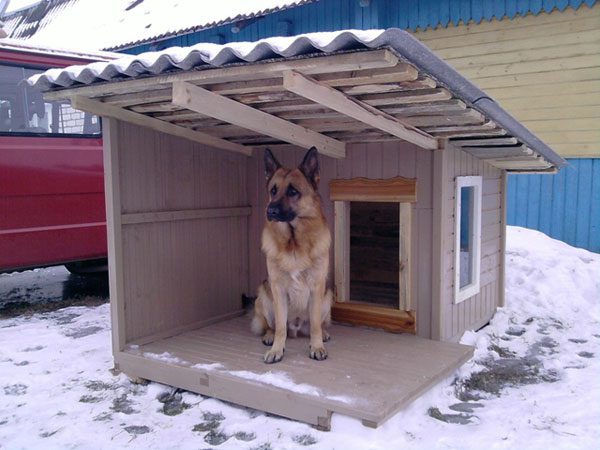
However, whether a dog freezes in a booth in winter depends not only on the breed, but also on the conditions in which the pet grew up. If earlier he lived in an apartment, then it will be difficult for him to spend the winter in a kennel without insulation. In a warm room, dogs shed more and lose their warming undercoat. It is necessary to gradually adapt the animal's body to new living conditions.
If the region is dominated by cold winters with long periods of "minus" temperatures, then it is better not to risk the pet's health and equip a warm booth for the dog.
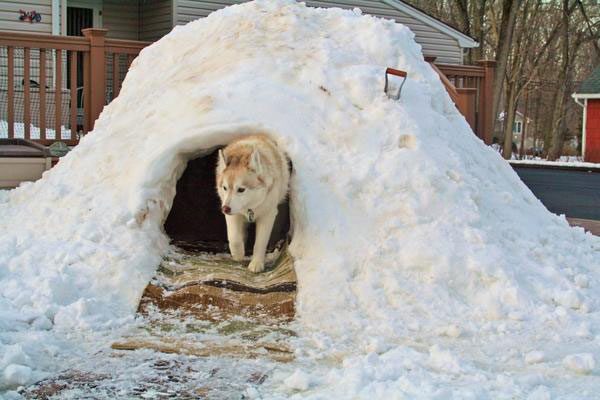
Compliance with a number of rules will help create an insulated kennel and reduce the heat loss of the structure:
The entrance to the pet's home is best located in a place where the likelihood of drafts is minimal.For the construction of walls, it is desirable to use wood - the material has a low thermal conductivity. The dog house must not be placed on bare ground. The structure must be placed on bricks or wooden beams. The air layer will protect the bottom from freezing. A draft for dogs is worse than frost. Therefore, the manhole must be curtained with a dense canopy. The material should be dense and weighted so as not to sway from the wind
It is important to maintain the optimal size. The dog will be able to heat a compact booth with his breath
However, in a building that is too close, the movement of the animal will be limited.

In the winter booth, it is necessary to exclude leaks - eliminate all cracks on the roof and take care of the waterproofing of the roof even before insulation.
Warming up
In addition to the fact that the owner chooses the option of insulation at his discretion, he still has to think about how to cover the manhole through which the lion's share of heat escapes. To do this, you need to make a curtain from felt, tarpaulin or other dense protective fabric (even from an old thin rug). The curtain is attached with screws and a wooden plank, while it is cut into equal strips so that the dog can go inside the house. Some owners advise making an attached vestibule to the booth with their own hands, so most of the heat can be kept inside the home.
Hay or sawdust can be laid on the floor of the booth; such bedding is regularly changed. Someone lays rags or rugs on the floor, but remember that the animal does not always understand the purpose of the rug and can simply tear it apart. It is better to replace the rug with burlap or coarse cloth stretched over a wooden frame.
In addition, any insulation must be securely protected from the inside of the booth. To do this, the interior of the booth is sheathed with clapboard, plywood, chipboard and OSB with their own hands.
And how to make the floor of the booth warmer with ordinary hay will tell the video below!
Insulation of a doghouse with felt
Let us consider in more detail the option of how to insulate the house of your four-legged guard with artificial felt.
- Roll of artificial felt.
- Sharp knife.
- Nails with wide caps.
Step-by-step instruction
Note that do-it-yourself insulation of the booth with felt is the easiest and cheapest option. In addition, felt, as we have already noted, is considered safe for your pet and you can not “hide” it from the dog.
So, in order to insulate the booth with felt, you need:
- Cut the felt into pieces equal in size to the walls with a sharp clerical knife.
- Attach pieces of felt to the walls with wide-head nails. You can also upholster the inside of the roof and floor.
- Felt does not have to be sheathed on top with wood or plywood. By the way, felt protects well from wind and moisture.
Don't forget to put a warm rug on the floor!
Warming with mineral wool
Warming the booth with mineral wool with your own hands is a more time-consuming process than the previous option. However, it should, in theory, provide higher thermal insulation if everything is done correctly.
- Mineral wool;
- Wooden blocks;
- Knife, nails, stapler;
- Vapor barrier;
- Plywood, chipboard or OSB.
Step-by-step instruction
- First, the roof is removed from the booth, and its walls are closed with a vapor barrier, which is attached with a stapler.
- Further, a crate of bars is stuffed onto all the walls.
- With a knife, "mats" of cotton wool are cut to the size of the crate and inserted into it.
- Next, the cotton wool is again covered with a layer of vapor barrier.
- This whole “sandwich” is tightly sheathed with wood, plywood, chipboard or OSB from above so that the dog cannot break the insulation structure.
As a result, the walls, insulated with mineral wool, are quite thick. By a similar principle, you can make insulation and foam. A rug on the floor will make your home more comfortable.
hay and straw
If your four-legged friend lives in outdoor conditions, then it is highly undesirable for him to use hay or straw as bedding. There is a high chance that your pet will become infected with parasites such as fleas and ticks. In addition, all organic bedding is characterized by the presence of enterobacteria: intestinal shelf, salmonella. Also in the straw and hay there are intestinal acne, causing a wide variety of diseases in dogs. Another significant disadvantage of these materials is that they cannot be disinfected.
However, despite all the dangers and warnings, many owners like to use hay and straw as bedding. They motivate this by the fact that these materials are environmentally friendly, have a pleasant smell and retain heat well.
To prepare hay for bedding, care must be taken not to overdry it. Periodically it must be shaken to avoid the charm of hay. To prevent infection with parasites, it is necessary to regularly, every week make new bedding with the addition of herbs with antiparasitic properties: thyme, sage, wormwood. The litter must be shaken every day.
For harvesting straw bedding, it is best to use plants with a hard stem (rye, wheat, reeds). Oat straw is definitely not suitable for this purpose, as it tends to crumble very much.
How to make a warm booth for a dog drawings, photo
Do-it-yourself insulated doghouse for a dog: drawings and dimensions. Step-by-step photo instructions for making a dog house from boards and insulation.
First you need to decide on the size of the booth, which in turn depends on the size of the pet. The booth should not be large, because the dog will not be able to warm up well in a large kennel, the optimal size of the internal space of the booth should be such that the dog can freely turn around in the booth, the height of the booth is equal to the height of the dog with his head up.
The optimal size of the booth for some types of dogs.
To make an insulated booth, you will need timber, boards and insulation. Foam or mineral wool can be used as insulation. You can use nails to fasten the boards, but self-tapping screws are more reliable.
Step-by-step production of a warm booth for a dog: drawings, diagram, photo.
Consider the process of making a booth step by step with drawings.
1.STEP. Let's make the base for the booth.
2.STEP. Niche under the heater.
We need a bar with a section of 50 x 50 mm. We saw it into bars, two bars of 90 cm and two of 60 cm each. We fasten the bars to the base.
3.STEP. Insulation lining.
4. STEP. Booth floor.
We will need boards 90 cm long, we sheathe the insulation with boards, we fasten the boards with self-tapping screws to the timber.
5. STEP. Side walls of the booth.
Now we need to make two side walls, we use boards 65 cm long and bars 40 cm. We fasten the walls to the floor using metal corners and self-tapping screws, as an option, you can first fix the horizontal bar at the bottom of each wall, then screw the bars to the floor with self-tapping screws , the distance between the walls is 70 cm.
6. STEP. Front and rear walls of the booth.
7. STEP. We fasten all the walls of the booth together with self-tapping screws.
8. STEP. We lay insulation on the walls of the booth (we do not forget about the vapor barrier for mineral wool).
9. STEP. We sheathe the walls of the booth with boards.
10. STEP. Booth roof. We fix the roof boards to the walls.
11. STEP. We fasten the bars under the insulation.
12. STEP. We install a heater.
14. STEP. We sheathe roof insulation with boards.
Where is the best place to set up a dog house?
The booth should be installed in the courtyard of the house in such a way that the dog has a good view of the courtyard and the entrance gate, but at the same time, during the scorching heat, the booth should be in the shade of buildings, a fence or a tree. In winter, do not forget about the bedding for the dog, the booth should be half filled with hay or straw to make it easier for the dog to warm up.
«>
Kennel insulation technology
Floor and bottom
- You need to start work with floor insulation and bottom protection. To do this, turn the structure upside down. Treat the surface with protective agents from the destruction of the material and cover with roofing material (can be fixed with bars). Thus, the external protection of the floor is performed.
- Turn the booth over and continue warming the floor. Line the floor with an insulating film, it can be the same roofing material or glassine. So that there are no gaps, it is better to overlap it and shoot it with a construction stapler, and also, well, put a film on the walls.
- This is followed by a layer of insulation, which must be closed. If the insulation is voluminous or too soft, it is better to fill the bars (such as a log) for mounting the finished floor.
- Finished flooring. To do this, you can use a regular (pre-treated) board or boards (plywood, OSB).
- To prevent the booth floors from freezing and numbing, it is recommended to do additional insulation work. At the installation site of the booth, according to its size, it is necessary to make a shallow excavation (up to 20 cm), fill it with gravel or expanded clay, cover it with an insulating film (roofing material) on top, which should come to the surface. With external insulation, it is hemmed under the cladding. If you install the booth on a similar sole, this will minimize the freezing of the floor and protect it from water.
Walls
The walls are insulated according to the standard scheme for each insulation. Step by step it looks like this:
- wall processing;
- waterproofing (if necessary);
- fastening (installation) of a heater;
- vapor barrier (if necessary);
- wall decoration (when using certain heaters).
The main condition for insulating the walls of a doghouse is to prevent the space being blown through and water getting inside it.
Roof and ceiling

The roof-ceiling in one version is suitable for a booth located in an aviary with a canopy, where leakage is almost impossible, otherwise, it is better to make a pitched roof for the kennel, and it must be removable.
The so-called "attic" of the roof is insulated in the same way as the floor. First we fix an insulating film on it, then a heater. When the roof is insulated, the dog will not have access to it, so there is no need to close it.
It is also better to protect the internal slopes of the roof from wind and moisture, for this you need to beat them around the perimeter with insulation or insulating material.
How to insulate a dog house with mineral wool
Often, a dog house is insulated with mineral wool. But this option has certain difficulties. Mineral wool retains heat better. Among the materials for work, you will need mineral wool, plywood, a vapor barrier and wooden beams. With tools, stock up on a stapler and nails.
Stages of insulation with mineral wool:
- First, the roof of the booth is disassembled. Then the vapor barrier is laid on the walls using a stapler.
- Then a lathing of beams is made on the walls.
- Mineral wool is mounted on the crate. You should measure and cut the necessary pieces in advance. Mineral wool is neatly placed between the bars.
- A vapor barrier is laid on the mineral wool.
- The final step will be sheathing the internal surfaces with plywood.
Insulation for booths thickens the walls in the booth. Because of this, the area of \u200b\u200bthe dwelling is reduced. For greater dog comfort, you can create warm floors by laying a bedding or rug.
The better to insulate a booth for a dog step by step instructions
You do not want your dog to freeze in winter, but there is no place to buy a suitable booth? You can make a pet house comfortable at home. How and what is better to insulate a booth for a dog with your own hands.
When to insulate a booth
An uninsulated dog house can keep out wind, rain, and direct sunlight, but not the cold. Warming is recommended for:
- all dogs living outside during the cold season;
- puppies and older pets, as well as dogs in poor health all year round.
Warming can be “built on” to an existing booth or done during the construction of a dog house.
Necessary tools and materials
To insulate the booth, you will need the following:
- rescue blanket;
- vapor barrier film;
- rigid polymer thermal insulation;
- bubble wrap;
- wall insulation;
- wall panels;
- plywood;
- carpet covering;
- wooden pallets.
It is also recommended to install a transparent plastic door, and pour hay inside the booth - the dog will make a cozy “nest” in it, and it will be even warmer. Do not use batting - when wet, it is ineffective, in addition, rodents start in it.
In order to insulate the floor, you must perform the following steps:
- Place a vapor barrier and a rescue blanket between the kennel and the ground (or concrete) on which it rests. This layer prevents the entry of dampness and cold air, as well as the leakage of heat. Replace the layer when it tears or becomes moldy.
- Create a platform under the booth. A wooden pallet topped with a sheet of plywood will lift the dog house above wet or cold ground. From below and on the sides, the pallet is closed with foam or bubble wrap.
- Make half a "sandwich". Additional layers of plywood sheets, lined with insulation, are placed inside the booth (if it is spacious) or outside (if it is small).
For roof insulation:
- Make thermal insulation. Use foil, plastic or bubble wrap. These materials are easy to cut and attach to the inside of the roof, and paneled on top.
- Reinforce the roof. Install rigid polymer thermal insulation and insulate it with panels or plywood.
- Reduce heat loss. From the outside, cover the roof with a tarp or wall insulation. In summer, this layer must be removed for natural ventilation of the booth.
For walls:
- Make sandwich walls. The steps are the same as when creating a “sandwich” floor, but panels are additionally installed on top.
- Hang carpet. Attach hooks to the walls of the booth and hang pieces of carpet on them. Do not use this method in areas with high humidity!
- Provide heat and moisture insulation. For this, a tarpaulin or other protective woven synthetic material that does not allow water to pass through is suitable.
https://.com/watch?v=lfs5vNeKyEA
Make sure that the dog does not start to gnaw and eat heaters - this can lead to serious health problems. Plywood and wall panels are needed to keep the animal from reaching the more dangerous (and chewable) inner layers. An additional budgetary way of warming - move the booth to the veranda from the ground or concrete.
- elatka
Best Answers
Nikolay Repalo: In the booth you need to put 2-2.5 kg of STRAW for 7 days. Every 7 days the bedding in the booth is changed. The hole is hung with an old rug, nailed with a bar at the top of the hole. Straw is also laid between the ground and the floor of the booth. The booth from three sides and the roof are covered with SNOW. Rags, old towels in the booth only prevent the dog from making a cozy warm bed out of straw, so they are not needed in the booth.
5th grade teacher: padushechku
In silence: can't you give the dog into good good hands??
And I .: hay will tear the pillow)
Yazva: it’s a pity for the dog ((poor short-haired and another puppy ((cover the booth with pinoplast and 2 layers of film on top, and better with thermal film, the booth should not be very large and the inlet should not be large, it is also hung on the sides with a tarpaulin
Viveya: From the inside, the walls of the booth can be insulated with cardboard (ordinary cardboard boxes), then with plywood. It is advisable to make a closed area (if possible, make sure that the entrance is not in the center, but a little on the edge) Again, spread several layers of cardboard down, then hay and unnecessary dense fabric that can be nailed with some smooth slats so that the dog did not get the resulting bedding. You can also hang the entrance a little with a thick cloth - only if the dog is not afraid of it.The place for the booth must be chosen so that the wind and drafts do not enter the entrance. In severe frosts, of course, it is better to take the shorthair home. Good luck!
blabla.alisa@mail/>nail a piece of thick foam to the bottom of the booth
Dasha Cherkasova: if you love a dog, buy her a heated mat
Bunny jumper: cover the booth with foam plastic and warm it normally with hay, and not with rags (in general, a good owner will not drive the dog out into the street in bad weather)
